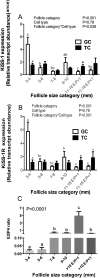Does kisspeptin exert a local modulatory effect on bovine ovarian steroidogenesis?
- PMID: 36745024
- PMCID: PMC9986390
- DOI: 10.1530/RAF-22-0088
Does kisspeptin exert a local modulatory effect on bovine ovarian steroidogenesis?
Abstract
Kisspeptin, a hypothalamic neuropeptide encoded by the KISS1 gene, has a pivotal role in promoting GnRH secretion in mammals. Kisspeptin and its receptor (KISS1R) are also expressed in certain peripheral tissues including gonads, suggesting intra-gonadal roles. Such actions at the level of the bovine ovary have not been explored previously. The current aims were to determine whether KISS1 and its receptor (KISS1R) are expressed in the bovine ovary and whether kisspeptin or a kisspeptin antagonist can modulate ovarian steroid production by cultured ovarian cells. Granulosa (GC) and theca interna (TC) were collected from antral follicles (3-18 mm) categorized into five class sizes. Early, mid and regressing corpora lutea (CL) were also collected for RT-qPCR analysis of KISS1 and KISS1R expression. Bovine TC and GC cultured under both non-luteinizing (serum-free) and luteinizing (serum-supplemented) conditions were treated for 4 days with kisspeptin-10 (10-10-10-6M) or kisspeptin antagonist (p234; 10-10-10-6M), alone and in combination with either FSH (GC), LH (TC) or forskolin (luteinized GC/TC). Steroid secretion (GC: oestradiol, progesterone; TC: androstenedione, progesterone; luteinized GC/TC: progesterone) was measured by ELISA and viable cell number determined by neutral red uptake assay. KISS1 and KISS1R transcripts were detected in TC, GC and CL with significant differences between follicle categories and CL stages. However, neither kisspeptin-10 nor kisspeptin antagonist affected steroid secretion or viable cell number in any of the four ovarian cell culture models. As such, the hypothesis that kisspeptin has a direct intra-ovarian role to modulate follicular or luteal steroidogenesis, or cell proliferation/survival, is not supported.
Conflict of interest statement
The authors declare that there is no conflict of interest that could be perceived as prejudicing the impartiality of the research reported.
Figures







Similar articles
-
The expression of kisspeptin and its receptor in the domestic cat ovary and uterus in different stages of the ovarian cycle.Theriogenology. 2018 Sep 1;117:40-48. doi: 10.1016/j.theriogenology.2018.05.019. Epub 2018 May 18. Theriogenology. 2018. PMID: 29843081
-
Expression of kisspeptin and its receptor in different functional classes of ovarian follicle in the buffalo (Bubalus bubalis).Theriogenology. 2022 Feb;179:87-96. doi: 10.1016/j.theriogenology.2021.11.017. Epub 2021 Nov 23. Theriogenology. 2022. PMID: 34861556
-
Expression of neurokinin B/NK3 receptor and kisspeptin/KISS1 receptor in human granulosa cells.Hum Reprod. 2014 Dec;29(12):2736-46. doi: 10.1093/humrep/deu247. Epub 2014 Oct 14. Hum Reprod. 2014. PMID: 25316443
-
Peripheral action of kisspeptin at reproductive tissues-role in ovarian function and embryo implantation and relevance to assisted reproductive technology in livestock: a review.Biol Reprod. 2020 Dec 1;103(6):1157-1170. doi: 10.1093/biolre/ioaa135. Biol Reprod. 2020. PMID: 32776148 Free PMC article. Review.
-
Local roles of TGF-beta superfamily members in the control of ovarian follicle development.Anim Reprod Sci. 2003 Oct 15;78(3-4):165-83. doi: 10.1016/s0378-4320(03)00089-7. Anim Reprod Sci. 2003. PMID: 12818643 Review.
Cited by
-
New Insights in Bovine Follicular Cysts.Reprod Domest Anim. 2025 Mar;60(3):e70048. doi: 10.1111/rda.70048. Reprod Domest Anim. 2025. PMID: 40056005 Free PMC article.
References
-
- Castellano JM, Navarro VM, Fernandez-Fernandez R, Nogueiras R, Tovar S, Roa J, Vazquez MJ, Vigo E, Casanueva FF, Aguilar Eet al.2005Changes in hypothalamic KiSS-1 system and restoration of pubertal activation of the reproductive axis by kisspeptin in undernutrition. Endocrinology 1463917–3925. (10.1210/en.2005-0337) - DOI - PubMed
LinkOut - more resources
Full Text Sources
Research Materials
Miscellaneous

